MITSUBISHI MIRAGE 2015 6.G Owners Manual
Manufacturer: MITSUBISHI, Model Year: 2015, Model line: MIRAGE, Model: MITSUBISHI MIRAGE 2015 6.GPages: 300, PDF Size: 43.44 MB
Page 241 of 300

How to change a tire (Vehicle
s equipped with spare tire)
8-16 For emergencies
8
N00850000175
Store the flat tire in the cargo area. Reverse the removing procedure when stor-ing the spare tire, jack, bar and wheel nut wrench. Refer to “To remove the spare tire” on page8-12 and “Jack and tools” on page 8-5.
N00849400225
Wrap the tip of the bar with a cloth, insert itinto the notch provided in the wheel cover, and pry the cover away from the wheel. Using the same procedur
e at the other wheel
cover notches, work the wheel cover away from the wheel to remove it completely.
1. Align the tire air valve (C) and the wheel cover notch (D).
CAUTION Driving with an imprope
rly inflated tire can
cause an accident. If
you have no choice but
to drive with an under-inflated tire, keepyour speed down and avoid sudden steering or braking, if possible. Inflate the tire to the correct pressure as soon as possible. Refer to“Tire inflation pressures” on page 9-14. After changing the tire
and driving the vehi-
cle about 620 miles (1,000 km), retighten the wheel nuts to make sure that they have not come loose. If the steering wheel vibrates when driving after changing th
e tire, have the tire checked
for balance at an authorized Mitsubishi Motors dealer or a re
pair facility of your
choice. Do not mix one type of
tire with another or
use a different size from the one listed. Thiswould cause early we
ar and poor handling.
To store the flat tire or spare tire, jack, bar and wheel nut wrench
Wheel cover (if so equipped) To r e m o v e
NOTE
The wheel cover is made
of plastic. Be care-
ful when prying it off.
CAUTION Trying to remove the
wheel cover with only
your bare hands can se
riously injure your
fingers.
To install
CAUTION Before installing the wheel cover to the wheel, make sure that the tabs (A) on the back of the wheel cover correctly engage the ring (B) to prevent the wheel cover fromcoming off. Do not install a wheel cover that has broken tabs.
BK0212400US.book 16 ページ 2014年4月1日 火曜日 午後2時21分
Page 242 of 300

Towing
For emergencies 8-17
8
2. Push the bottom (F) of the wheel cover into the wheel. 3. Gently push in both sides (G) of the wheelcover and hold them in place with both knees. 4. Gently tap around th
e circumference of
the wheel cover at the top (H), then push the wheel cover into place.
N00837000888
If towing is necessary,
we recommend you to
have it done by a commercial tow truck ser- vice.When towing is required, transport the vehi- cle using a tow truck. Incorect towing equipment could damageyour vehicle.
There may be local regulations concerning towing in your area. Obey the regulations of the area where you are driving your vehicle.
NOTE
Full wheel covers have
a symbol mark (E)
provided on the reverse side to show the airvalve location. Before installing the wheel cover to the wheel, make sure that the opening with thesymbol mark is correctl
y aligned with the air
valve.
To w i n g If your vehicle needs to be towed
CAUTION Do not attempt to be towed by another vehi- cle with a rope.
NOTE
Do not use the tie-down hooks for towing. These hooks are provided only for the pur-pose of transporting the vehicle itself. Your vehicle cannot tow any other vehicle.Do not tow CVT vehicles with this style.
BK0212400US.book 17 ページ 2014年4月1日 火曜日 午後2時21分
Page 243 of 300
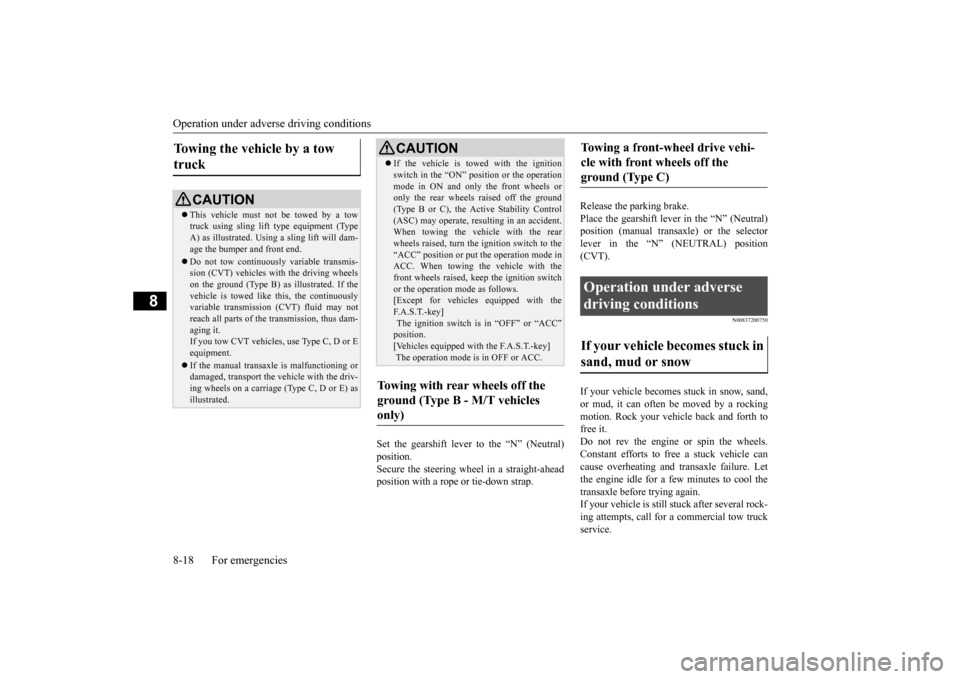
Operation under adverse driving conditions 8-18 For emergencies
8
Set the gearshift lever to the “N” (Neutral) position. Secure the steering whee
l in a straight-ahead
position with a rope or tie-down strap.
Release the parking brake. Place the gearshift lever in the “N” (Neutral)position (manual transaxle) or the selector lever in the “N” (NEUTRAL) position (CVT).
N00837200750
If your vehicle becomes
stuck in snow, sand,
or mud, it can often be moved by a rocking motion. Rock your vehicle back and forth tofree it. Do not rev the engine or spin the wheels. Constant efforts to free a stuck vehicle cancause overheating and tr
ansaxle failure. Let
the engine idle for a few minutes to cool the transaxle before trying again.If your vehicle is still
stuck after several rock-
ing attempts, call for a commercial tow truck service.
Towing the vehicle by a tow truck
CAUTION This vehicle must not be towed by a tow truck using sling lift
type equipment (Type
A) as illustrated. Usi
ng a sling lift will dam-
age the bumper and front end. Do not tow continuously variable transmis- sion (CVT) vehicles with the driving wheels on the ground (Type B) as illustrated. If the vehicle is towed like
this, the continuously
variable transmission (CVT) fluid may not reach all parts of the transmission, thus dam- aging it.If you tow CVT vehicles, use Type C, D or E equipment. If the manual transaxle is malfunctioning or damaged, transport the
vehicle with the driv-
ing wheels on a carriage (Type C, D or E) asillustrated.
If the vehicle is towed with the ignition switch in the “ON” pos
ition or the operation
mode in ON and only the front wheels oronly the rear wheels raised off the ground (Type B or C), the Acti
ve Stability Control
(ASC) may operate, resul
ting in an accident.
When towing the vehicle with the rear wheels raised, turn the ignition switch to the “ACC” position or put
the operation mode in
ACC. When towing the vehicle with the front wheels raised, ke
ep the ignition switch
or the operation mode as follows.[Except for vehicles equipped with the F. A . S . T. - k e y ] The ignition switch is in “OFF” or “ACC”position. [Vehicles equipped with the F.A.S.T.-key] The operation mode is in OFF or ACC.
Towing with rear wheels off the ground (Type B - M/T vehicles only)
CAUTION
Towing a front-wheel drive vehi- cle with front wheels off the ground (Type C) Operation under adverse driving conditions If your vehicle becomes stuck in sand, mud or snow
BK0212400US.book 18 ページ 2014年4月1日 火曜日 午後2時21分
Page 244 of 300
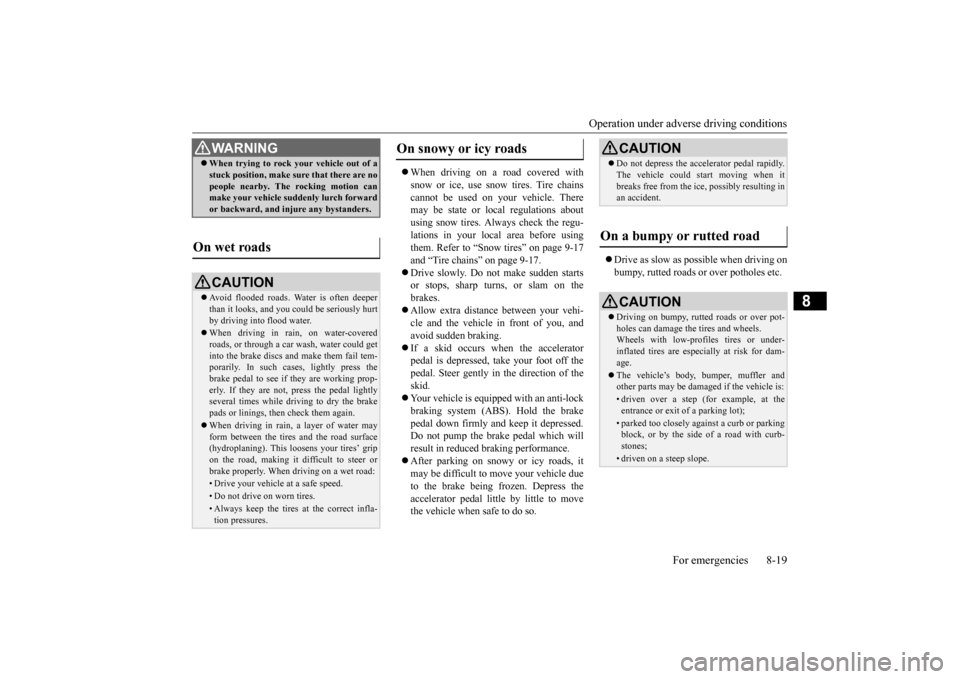
Operation under adverse driving conditions
For emergencies 8-19
8
When driving on a road covered with snow or ice, use s
now tires. Tire chains
cannot be used on your vehicle. There may be state or local regulations aboutusing snow tires. Al
ways check the regu-
lations in your local area before using them. Refer to “Snow tires” on page 9-17and “Tire chains” on page 9-17. Drive slowly. Do not make sudden starts or stops, sharp turns, or slam on the brakes. Allow extra distance between your vehi- cle and the vehicle in front of you, and avoid sudden braking. If a skid occurs when the accelerator pedal is depressed, take your foot off the pedal. Steer gently in the direction of the skid. Your vehicle is equipped with an anti-lock braking system (ABS). Hold the brake pedal down firmly and keep it depressed.Do not pump the brake pedal which will result in reduced braking performance. After parking on snowy or icy roads, it may be difficult to move your vehicle due to the brake being frozen. Depress the accelerator pedal little by little to movethe vehicle when safe to do so.
Drive as slow as pos
sible when driving on
bumpy, rutted roads or over potholes etc.
WA R N I N G When trying to rock
your vehicle out of a
stuck position, make sure that there are nopeople nearby. The
rocking motion can
make your vehicle suddenly lurch forward or backward, and inju
re any bystanders.
On wet roads
CAUTIONAvoid flooded roads. Water is often deeper than it looks, and you could be seriously hurtby driving into flood water. When driving in rain, on water-covered roads, or through a car
wash, water could get
into the brake discs a
nd make them fail tem-
porarily. In such cases, lightly press thebrake pedal to see if they are working prop- erly. If they are not, press the pedal lightly several times while driving to dry the brakepads or linings, then check them again. When driving in rain, a layer of water may form between the tires and the road surface (hydroplaning). This loosens your tires’ grip on the road, making it difficult to steer orbrake properly. When driving on a wet road:• Drive your vehicle at a safe speed.• Do not drive on worn tires.• Always keep the tires at the correct infla-tion pressures.
On snowy or icy roads
CAUTION Do not depress the acce
lerator pedal rapidly.
The vehicle could start moving when itbreaks free from the
ice, possibly resulting in
an accident.
On a bumpy or rutted road
CAUTION Driving on bumpy, rutted roads or over pot- holes can damage th
e tires and wheels.
Wheels with low-profiles tires or under-inflated tires are especially at risk for dam- age. The vehicle’s body, bumper, muffler and other parts may be dama
ged if the vehicle is:
• driven over a step (for example, at the entrance or exit of a parking lot);• parked too closely against a curb or parkingblock, or by the side of a road with curb- stones;• driven on a steep slope.
BK0212400US.book 19 ページ 2014年4月1日 火曜日 午後2時21分
Page 245 of 300
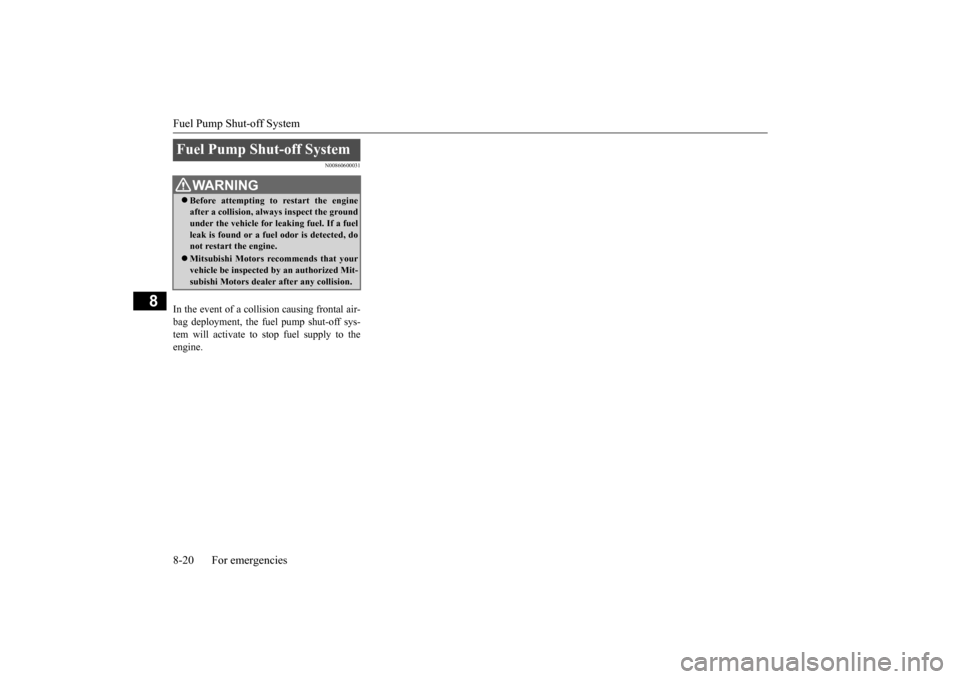
Fuel Pump Shut-off System 8-20 For emergencies
8
N00860600031
In the event of a collision causing frontal air- bag deployment, the fuel pump shut-off sys-tem will activate to st
op fuel supply to the
engine.Fuel Pump Shut-off System
WA R N I N G Before attempting to restart the engine after a collision, alw
ays inspect the ground
under the vehicle for leaking fuel. If a fuel leak is found or
a fuel odor is detected, do
not restart the engine. Mitsubishi Motors recommends that your vehicle be inspected by
an authorized Mit-
subishi Motors dealer
after any collision.
BK0212400US.book 20 ページ 2014年4月1日 火曜日 午後2時21分
Page 246 of 300
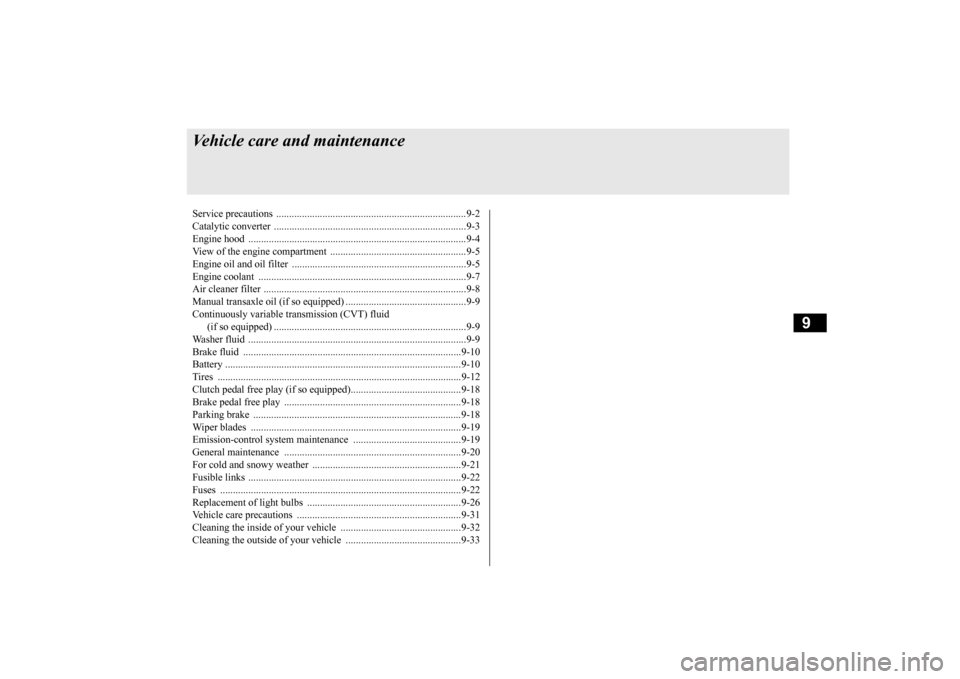
9
Vehicle care and maintenanceService precautions ..........................................................................9-2 Catalytic converter ...........................................................................9-3 Engine hood .........
...........
...........
............
...........
.........
........
.........
.....9-4
View of the engine compartment .....................................................9-5 Engine oil and oil filter ....................................................................9-5 Engine coolant .................................................................................9-7Air cleaner filter ...............................................................................9-8 Manual transaxle oil (if so equipped) ...............................................9-9 Continuously variable transmission (CVT) fluid (if so equipped) ...........................................................................9-9 Washer fluid .....................................................................................9-9 Brake fluid .....................................................................................9-10Battery ............................................................................................9-10 Tires ...............................................................................................9-12 Clutch pedal free play (if so equipped)...........................................9-18Brake pedal free play .....................................................................9-18 Parking brake .................................................................................9-18 Wiper blades ..................................................................................9-19Emission-control system maintenance ..........................................9-19 General maintenance .....................................................................9-20 For cold and snowy weather ..........................................................9-21Fusible links ...................................................................................9-22 Fuses ..............................................................................................9-22 Replacement of light bulbs ............................................................9-26Vehicle care precautions ................................................................9-31 Cleaning the inside of your vehicle .......
...........
...........
...........
.......9-32
Cleaning the outside of your vehicle .....
...........
...........
...........
.......9-33
BK0212400US.book 1 ページ 2014年4月1日 火曜日 午後2時21分
Page 247 of 300

Service precautions 9-2 Vehicle care and maintenance
9
N00937300387
Taking regular care of your vehicle will pre- serve its value and appe
arance as long as pos-
sible. You can do some of the maintenance work yourself, and the rest should only be per- formed by an authorized Mitsubishi Motors dealer or a repair facility of your choice. If you discover a malfunction or other prob- lem, have it corrected by an authorizedMitsubishi Motors dealer
or a repair facility
of your choice. This section descri
bes the maintenance
inspections that you can do yourself, if you so desire. Follow the instructions and precau- tions for each procedure.
Have you purchased the Mitsubishi Motors Diamond Care Protection Plan? The Plansupplements your new
vehicle warranties.
See your authorized Mitsubishi Motors dealer for details. Only use the designated positions shown in the illustration.
Service precautions
WA R N I N G When checking or servicing the inside of the engine compartment, be sure the engine is stopped and has had a chance tocool down. If you need to work in the engine compart- ment with the engine running, be espe- cially careful that you
r clothing, hair, etc.
does not get caught in the fan, drive belts,or other moving parts.
The fan can turn on automatically even if the engine is not running. Turn the igni-tion switch to the “OFF” position or putthe operation mode in OFF to be safe while you work in
the engine compart-
ment. Do not smoke or allow open flames around fuel or the battery. The fumes are flamma-ble. Be extremely careful when working around the battery. It
contains poisonous
and corrosive sulfuric acid. Do not get under your ve
hicle while it is on
a jack. Always use properly rated automotivejack stands. Handling your vehicle’s parts and materi- als in the wrong way can injure you. Ask an authorized Mitsub
ishi Motors dealer
or a repair facility of your choice if youhave questions.WA R N I N G
If your vehicle is raised with a garage jack * - Front of the vehicle
Never use the rear suspensions as a jack- ing point.
BK0212400US.book 2 ページ 2014年4月1日 火曜日 午後2時21分
Page 248 of 300
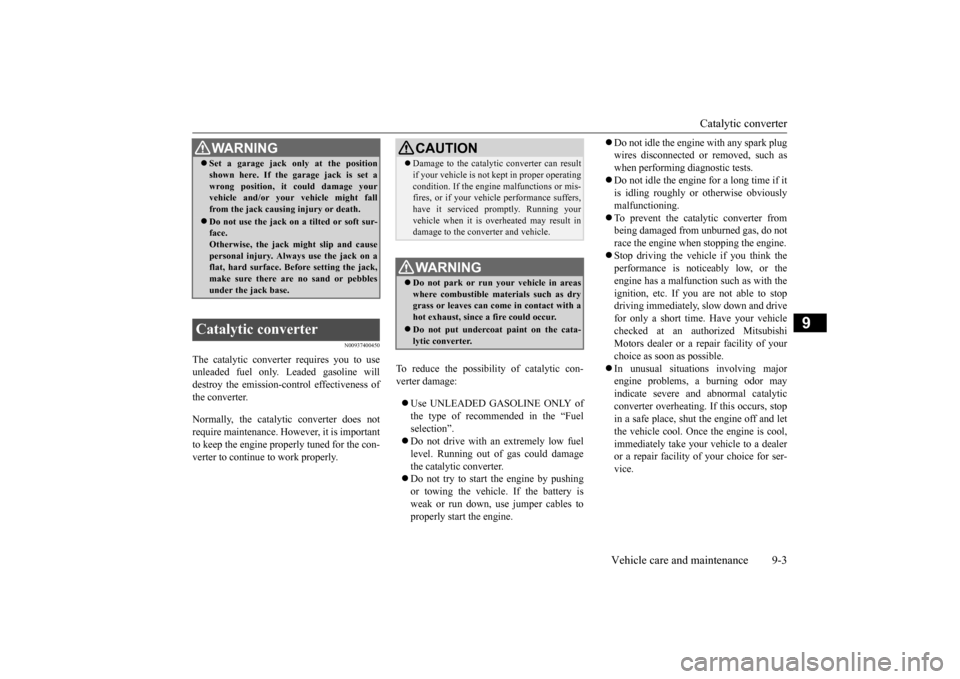
Catalytic converter
Vehicle care and maintenance 9-3
9
N00937400450
The catalytic converter requires you to use unleaded fuel only. Leaded gasoline will destroy the emission-c
ontrol effectiveness of
the converter. Normally, the catalyti
c converter does not
require maintenance. However, it is important to keep the engine properly tuned for the con- verter to continue to work properly.
To reduce the possibili
ty of catalytic con-
verter damage: Use UNLEADED GASOLINE ONLY of the type of recommended in the “Fuel selection”. Do not drive with an extremely low fuel level. Running out of gas could damage the catalytic converter. Do not try to start the engine by pushing or towing the vehicle. If the battery is weak or run down, use jumper cables toproperly start the engine.
Do not idle the engine with any spark plug wires disconnected or
removed, such as
when performing diagnostic tests. Do not idle the engine for a long time if it is idling roughly or otherwise obviouslymalfunctioning. To prevent the catalytic converter from being damaged from unburned gas, do notrace the engine when stopping the engine. Stop driving the vehicle if you think the performance is noticeably low, or the engine has a malfunction such as with the ignition, etc. If you are not able to stopdriving immediately, slow down and drive for only a short time.
Have your vehicle
checked at an authorized MitsubishiMotors dealer or a repair facility of your choice as soon
as possible.
In unusual situations involving major engine problems, a burning odor may indicate severe a
nd abnormal catalytic
converter overheating. If this occurs, stopin a safe place, shut
the engine off and let
the vehicle cool. Once the engine is cool, immediately take your
vehicle to a dealer
or a repair facility of
your choice for ser-
vice.
WA R N I N G Set a garage jack only at the position shown here. If the gar
age jack is set a
wrong position, it could damage yourvehicle and/or your
vehicle might fall
from the jack causing injury or death. Do not use the jack on a tilted or soft sur- face. Otherwise, the jack might slip and causepersonal injury. Always
use the jack on a
flat, hard surface. Before setting the jack, make sure there are no sand or pebblesunder the jack base.
Catalytic converter
CAUTION Damage to the catalytic
converter can result
if your vehicle is not
kept in proper operating
condition. If the engine
malfunctions or mis-
fires, or if your vehi
cle performance suffers,
have it serviced
promptly. Running your
vehicle when it is ove
rheated may result in
damage to the conve
rter and vehicle.
WA R N I N GDo not park or run your vehicle in areas where combustible materials such as dry grass or leaves can come
in contact with a
hot exhaust, since a fire could occur. Do not put undercoat paint on the cata- lytic converter.
BK0212400US.book 3 ページ 2014年4月1日 火曜日 午後2時21分
Page 249 of 300
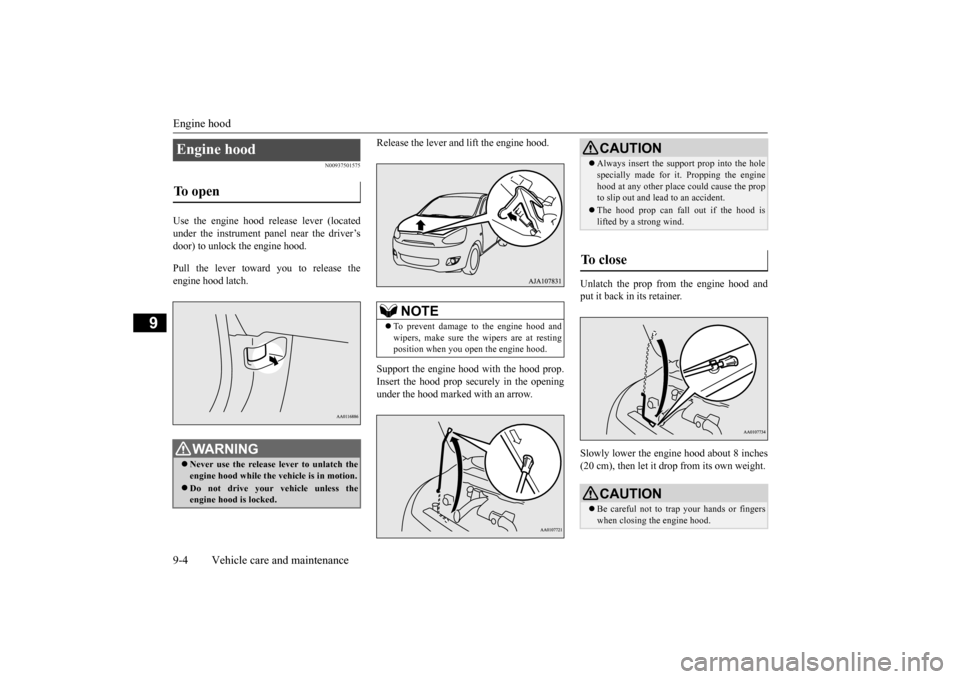
Engine hood 9-4 Vehicle care and maintenance
9
N00937501575
Use the engine hood re
lease lever (located
under the instrument panel near the driver’s door) to unlock the engine hood. Pull the lever toward you to release the engine hood latch.
Release the lever and
lift the engine hood.
Support the engine hood with the hood prop. Insert the hood prop securely in the opening under the hood marked with an arrow.
Unlatch the prop from the engine hood and put it back in its retainer. Slowly lower the engine hood about 8 inches (20 cm), then let it drop from its own weight.
Engine hood To open
WA R N I N G Never use the release lever to unlatch the engine hood while the
vehicle is in motion.
Do not drive your vehicle unless the engine hood is locked.
NOTE
To prevent damage to the engine hood and wipers, make sure the wipers are at restingposition when you open the engine hood.
CAUTION Always insert the support prop into the hole specially made for
it. Propping the engine
hood at any other place could cause the propto slip out and lead to an accident. The hood prop can fall out if the hood is lifted by a strong wind.
To close
CAUTION Be careful not to trap your hands or fingers when closing the engine hood.
BK0212400US.book 4 ページ 2014年4月1日 火曜日 午後2時21分
Page 250 of 300
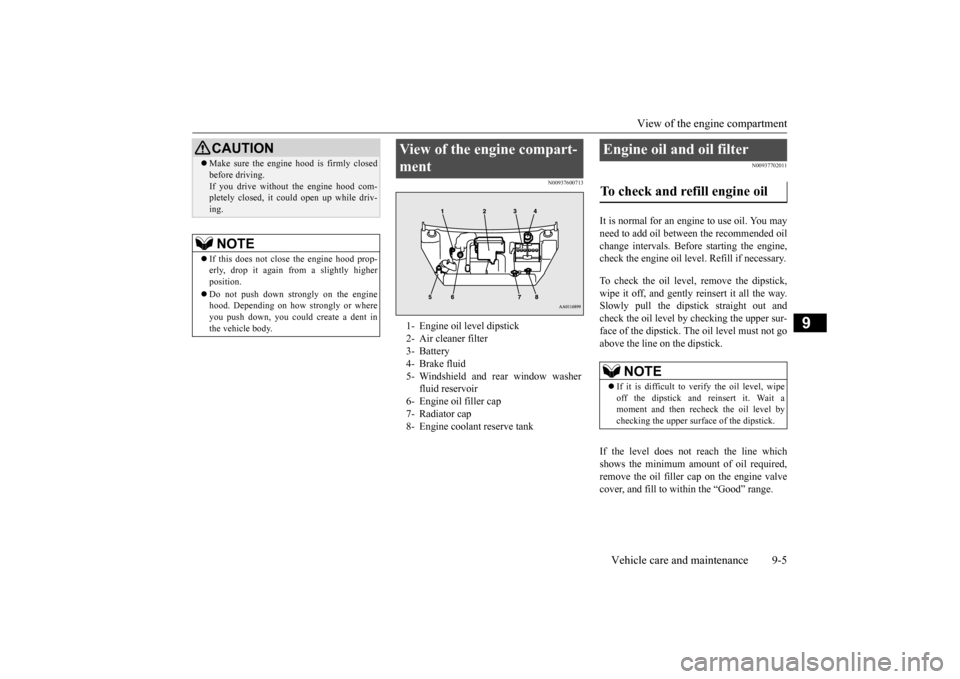
View of the engine compartment
Vehicle care and maintenance 9-5
9
N00937600713
N00937702011
It is normal for an engi
ne to use oil. You may
need to add oil betwee
n the recommended oil
change intervals. Before starting the engine,check the engine oil level. Refill if necessary. To check the oil level, remove the dipstick, wipe it off, and gently
reinsert it all the way.
Slowly pull the dipsti
ck straight out and
check the oil level by checking the upper sur- face of the dipstick. Th
e oil level must not go
above the line on the dipstick. If the level does not reach the line which shows the minimum amo
unt of oil required,
remove the oil filler cap on the engine valve cover, and fill to within the “Good” range.
Make sure the engine hood is firmly closed before driving.If you drive without the engine hood com-pletely closed, it c
ould open up while driv-
ing.NOTE
If this does not clos
e the engine hood prop-
erly, drop it again from a slightly higher position. Do not push down strongly on the engine hood. Depending on how strongly or whereyou push down, you could create a dent in the vehicle body.CAUTION
View of the engine compart- ment 1- Engine oil level dipstick 2- Air cleaner filter3- Battery 4- Brake fluid 5- Windshield and rear window washer
fluid reservoir
6- Engine oil filler cap 7- Radiator cap8- Engine coolan
t reserve tank
Engine oil and oil filter To check and refill engine oil
NOTE
If it is difficult to verify the oil level, wipe off the dipstick and
reinsert it. Wait a
moment and then recheck the oil level by checking the upper surfa
ce of the dipstick.
BK0212400US.book 5 ページ 2014年4月1日 火曜日 午後2時21分